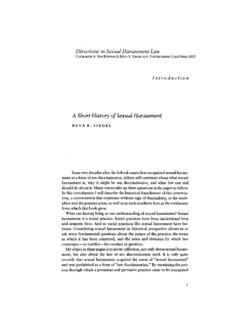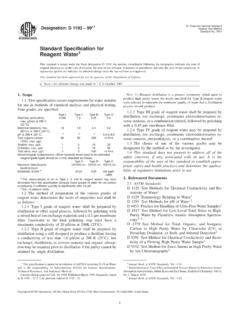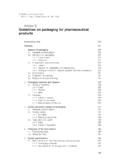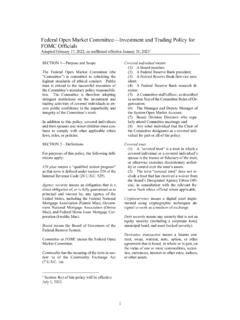Transcription of The Role of Rubrics in Advancing and Assessing Student ...
1 The Journal of Effective Teaching an online journal devoted to teaching excellence The Journal of Effective Teaching, Vol. 7, No. 1, 2007 3-14 2007 All rights reserved The Role of Rubrics in Advancing and Assessing Student Learning Kenneth Wolf and Ellen Stevens University of Colorado at Denver and Health Sciences Center _____ Abstract A rubric is a multi-purpose scoring guide for Assessing Student products and perform-ances. This tool works in a number of different ways to advance Student learning, and has great potential in particular for non-traditional, first generation, and minority stu-dents. In addition, Rubrics improve teaching, contribute to sound assessment, and are an important source of information for program improvement.
2 In this article, we discuss key features of a quality rubric, present an example of a rubric for Assessing a social science research study, and describe three basic steps in designing an effective rubric. Keywords: Rubrics , assessment, planning, instructional design. _____ While schoolteachers and their students have long seen the value of assessment Rubrics , our experience in working with faculty is that Rubrics have been largely ignored in higher education contexts (with the exception of Schools of Education). These multi-purpose scoring guides for Assessing Student products and performances work in a number of dif-ferent ways to advance the goals of an educational program.
3 Not only do Rubrics contrib-ute to Student learning, they have great potential for non-traditional, first generation, and minority students. As well, Rubrics improve teaching, provide feedback to students, con-tribute to sound assessment, and are an important source of information for program im-provement. So, what exactly are Rubrics ? How are they developed? What are their key features? Why are they useful? What are their limitations? What role can they play in program im-provement? These questions, and more, will be addressed in this article. Before we define and describe Rubrics , here are a couple of scenarios to help set the stage (modified from Arter & McTighe, 2001, pp.)
4 X-xi): An undergraduate Student in an American History course spent many hours work-ing on her museum display on the Gold Rush. She received a B on her project with no other comments. She expressed concern that she had met the project guidelines and asked the professor what she could have done to get an A. The professor responded, I reserve A for a highly creative project. When asked for Corresponding author's email: Wolf and Stevens 4 The Journal of Effective Teaching, Vol.
5 7, No. 1, 2007 3-14 2007 All rights reserved an example, the professor replied, Well, you could have presented it from the point of view of the Native Americans affected by the Gold Rush. What s the problem There are no explicit performance criteria to inform students in creating their projects or to guide the professor in Assessing them. A rubric here could help address this situation. How do you think this Student felt? Probably the same way that students in any course feel when the criteria for an assignment are ambiguous and the assessment seems arbi-trary. When the curriculum is hidden, students who can t guess what the expectations are will be more at risk than those who know how to play the game (Jackson, 1990).
6 A good rubric can take the mystery out of assignments for all students. As Eisner notes: More than what educators say, more than what they write in curriculum guides, evalua-tion practices tell both students and teachers what counts. How these practices are em-ployed, what they address and what they neglect, and the form in which they occur speak forcefully to students about what adults believe is important (Eisner, 1991, p. 81). Now, let s look at another scenario: In an English department class, a professor introduced her students to the qualities of an effective oral presentation by showing them videotaped examples of excel-lent, as well as poor, speeches and presentations.
7 Guided by the teacher, the stu-dents identified four key criteria (traits) that they agreed were important for an ef-fective speech content, organization, delivery, and language. They defined each of these and what would constitute strong, middle, and weak performance on each trait. They then referred to these performance criteria when preparing their own speeches, and the teacher used the same criteria when providing feedback on, and grading, their presentations. What s going on in this scenario? Not only are there criteria that define the features of a speech, but the professor has shown strong and weak examples of oral presentations and even invited the students to generate evaluation criteria based on these examples and their own experiences.
8 Clearly, both students and professor use the criteria in talking about and giving feedback on the speeches. In other words, the learning process is anchored by a rubric--a scoring tool used to evaluate a performance in a given outcome area based on a list of criteria describing the characteristics of products or performances at varying levels of accomplishment. A Rubric for Springboard Diving We always have criteria in mind when we evaluate something whether it s a piece of art or a dive off a springboard. It s just that these criteria aren t always explicit, sometimes even to ourselves. When we judge a springboard diver s performance as good or bad, for example, we are basing that judgment on something.
9 We have some criteria in mind. Maybe it s the number of body rotations or the splash the diver makes on entry. Maybe it s something that really has nothing to do with the performance itself such as the diver s The Role of Rubrics 5 The Journal of Effective Teaching, Vol. 7, No. 1, 2007 3-14 2007 All rights reserved smile or nationality. As we become more informed about springboard diving, though, we may begin to draw on the five criteria used by the professional association (Federation Internationale de Na-tation, 2006): Starting Position, Take Off, Approach, Flight, and Entry.
10 These criteria are then elaborated in a rubric that describes what we mean by each. Entry, for example, is based on a number of considerations about body position. The entry into the water shall in all cases be vertical, or nearly so, with the body straight, the feet together and the toes pointed. When the entry is short or over, the judge shall deduct according to his opinion (p. x). Each of these criteria is then described on six levels of performance from com-plete failure to very good (see Table 1). A rubric in springboard diving makes it more clear to the judges how to rate the perform-ance, though these judges still need to draw on their extensive professional knowledge in applying these criteria.















